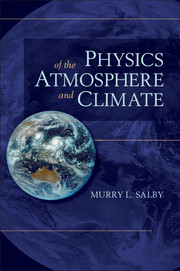Book contents
- Frontmatter
- Contents
- Preface
- Prelude
- 1 The Earth-atmosphere system
- 2 Thermodynamics of gases
- 3 The Second Law and its implications
- 4 Heterogeneous systems
- 5 Transformations of moist air
- 6 Hydrostatic equilibrium
- 7 Static stability
- 8 Radiative transfer
- 9 Aerosol and cloud
- 10 Atmospheric motion
- 11 Atmospheric equations of motion
- 12 Large-scale motion
- 13 The planetary boundary layer
- 14 Wave propagation
- 15 The general circulation
- 16 Dynamic stability
- 17 Influence of the ocean
- 18 Interaction with the stratosphere
- Appendix A Conversion to SI units
- Appendix B Thermodynamic properties of air and water
- Appendix C Physical constants
- Appendix D Vector identities
- Appendix E Curvilinear coordinates
- Appendix F Pseudo-adiabatic chart
- Appendix G Acronyms
- Answers to selected problems
- References
- Index
- Plate section
8 - Radiative transfer
Published online by Cambridge University Press: 05 June 2012
- Frontmatter
- Contents
- Preface
- Prelude
- 1 The Earth-atmosphere system
- 2 Thermodynamics of gases
- 3 The Second Law and its implications
- 4 Heterogeneous systems
- 5 Transformations of moist air
- 6 Hydrostatic equilibrium
- 7 Static stability
- 8 Radiative transfer
- 9 Aerosol and cloud
- 10 Atmospheric motion
- 11 Atmospheric equations of motion
- 12 Large-scale motion
- 13 The planetary boundary layer
- 14 Wave propagation
- 15 The general circulation
- 16 Dynamic stability
- 17 Influence of the ocean
- 18 Interaction with the stratosphere
- Appendix A Conversion to SI units
- Appendix B Thermodynamic properties of air and water
- Appendix C Physical constants
- Appendix D Vector identities
- Appendix E Curvilinear coordinates
- Appendix F Pseudo-adiabatic chart
- Appendix G Acronyms
- Answers to selected problems
- References
- Index
- Plate section
Summary
The thermal structure and stratification discussed in Chaps. 6 and 7 are shaped in large part by radiative transfer. According to the global-mean energy budget (Fig. 1.32), of some 542 W m-2 that is absorbed by the atmosphere, more than 80% is supplied through radiative transfer: 368 W m-2 through absorption of LW radiation from the Earth's surface and another 68 W m-2 through direct absorption of SW radiation. Similarly, the atmosphere loses energy through LW emission to the Earth's surface and to space.
To maintain thermal equilibrium, components of the atmospheric energy budget must, on average, balance. Vertical transfers of radiant energy involved in this balance are instrumental in determining thermal structure and motion that characterize individual layers. Likewise, the dependence of radiative transfer on latitude, temperature, and cloud introduces horizontal variations into the energy budget. Those variations lead to net radiative heating at low latitude and net radiative cooling at middle and high latitudes (Fig. 1.34c). To maintain thermal equilibrium locally, the latter must be compensated by a poleward transfer of heat. This heat transfer is accomplished by the general circulation. The general circulation, in turn, is driven by the horizontal distribution of radiative heating and cooling. Understanding these features of the Earth-atmosphere system therefore requires an understanding of how radiation interacts with the atmosphere.
SHORTWAVE AND LONGWAVE RADIATION
Energy transfer in the atmosphere involves radiation in two distinct bands of wavelength: shortwave radiation emitted by the sun and long wave radiation emitted by the Earth's surface and atmosphere.
- Type
- Chapter
- Information
- Physics of the Atmosphere and Climate , pp. 203 - 265Publisher: Cambridge University PressPrint publication year: 2012

